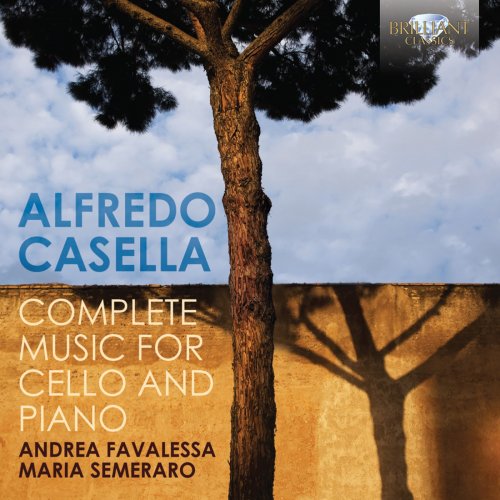
Andrea Favalessa, Maria Semeraro - Casella: Complete Music for Cello and Piano (2014)
BAND/ARTIST: Andrea Favalessa, Maria Semeraro
- Title: Casella: Complete Music for Cello and Piano
- Year Of Release: 2014
- Label: Brilliant Classics
- Genre: Classical
- Quality: flac lossless (tracks)
- Total Time: 00:58:38
- Total Size: 236 mb
- WebSite: Album Preview
Tracklist
01. Sonata No. 1 in C Minor, Op. 8: I. Allegro assai
02. Sonata No. 1 in C Minor, Op. 8: II. Adagio
03. Sonata No. 1 in C Minor, Op. 8: III. Allegro ma non troppo
04. Sonata No. 2 in C Major, Op. 45: I. Preludio. Largo molto e sostenuto
05. Sonata No. 2 in C Major, Op. 45: II. Bourée. Allegro molto vivace e scherzando
06. Sonata No. 2 in C Major, Op. 45: III. Largo
07. Sonata No. 2 in C Major, Op. 45: IV. Rondo. Allegro molto vivace, quasi giga
08. Notturno and Tarantella, Op. 54: No. 1, Notturno
09. Notturno and Tarantella, Op. 54: No. 2, Tarantella
Casella was, if it isn’t a contradiction in terms, a kind of neoclassical Romantic; of sufficient pianistic skill that he was admitted to the Paris Conservatoire at the age of 13 and thus perhaps escaped from the pressure to plough the furrow of operatic verismo already so well tilled by his countrymen. Instead he made his mark as a composer of abstract, instrumental music such as these two cello sonatas.
The First Sonata, like his other youthful compositions, reveals various stylistic influences: there are hints of Debussy, Mahler and Strauss, as well as traces of what Casella had learnt from Fauré. Even in these early works, however, the composer’s own personality comes across clearly in the search for what was new and hitherto unexplored ground. The Second Sonata reveals a change in compositional approach. In fact, it bears witness to his interest in a style that he defined as ‘baroque in its monumentality’. With its four movements it is more extensive, with dynamics based on deep contrasts between passages that are passionate and vigorous, and others in which the atmosphere is quietly intimate. The same rhythmic energy returns in the Tarantella, composed in 1929 along with the Notturno for violin and piano, transcribed by Luigi Silva in 1931, and ultimately reworked by Casella for cello and orchestra in 1934.
Andrea Favalessa and Maria Semeraro are young Italian musicians who regularly play together in a fruitful artistic partnership that has won them international recognition and numerous awards.
01. Sonata No. 1 in C Minor, Op. 8: I. Allegro assai
02. Sonata No. 1 in C Minor, Op. 8: II. Adagio
03. Sonata No. 1 in C Minor, Op. 8: III. Allegro ma non troppo
04. Sonata No. 2 in C Major, Op. 45: I. Preludio. Largo molto e sostenuto
05. Sonata No. 2 in C Major, Op. 45: II. Bourée. Allegro molto vivace e scherzando
06. Sonata No. 2 in C Major, Op. 45: III. Largo
07. Sonata No. 2 in C Major, Op. 45: IV. Rondo. Allegro molto vivace, quasi giga
08. Notturno and Tarantella, Op. 54: No. 1, Notturno
09. Notturno and Tarantella, Op. 54: No. 2, Tarantella
Casella was, if it isn’t a contradiction in terms, a kind of neoclassical Romantic; of sufficient pianistic skill that he was admitted to the Paris Conservatoire at the age of 13 and thus perhaps escaped from the pressure to plough the furrow of operatic verismo already so well tilled by his countrymen. Instead he made his mark as a composer of abstract, instrumental music such as these two cello sonatas.
The First Sonata, like his other youthful compositions, reveals various stylistic influences: there are hints of Debussy, Mahler and Strauss, as well as traces of what Casella had learnt from Fauré. Even in these early works, however, the composer’s own personality comes across clearly in the search for what was new and hitherto unexplored ground. The Second Sonata reveals a change in compositional approach. In fact, it bears witness to his interest in a style that he defined as ‘baroque in its monumentality’. With its four movements it is more extensive, with dynamics based on deep contrasts between passages that are passionate and vigorous, and others in which the atmosphere is quietly intimate. The same rhythmic energy returns in the Tarantella, composed in 1929 along with the Notturno for violin and piano, transcribed by Luigi Silva in 1931, and ultimately reworked by Casella for cello and orchestra in 1934.
Andrea Favalessa and Maria Semeraro are young Italian musicians who regularly play together in a fruitful artistic partnership that has won them international recognition and numerous awards.
As a ISRA.CLOUD's PREMIUM member you will have the following benefits:
- Unlimited high speed downloads
- Download directly without waiting time
- Unlimited parallel downloads
- Support for download accelerators
- No advertising
- Resume broken downloads


